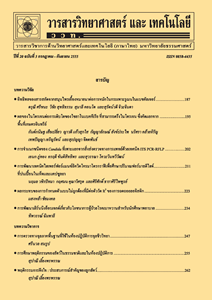ปริมาณและคุณภาพของสารอินทรีย์ที่เกิดขึ้นในสังคมพืชป่าชายเลนที่มีแสมขาวเป็นพันธุ์ไม้เด่น
Main Article Content
Abstract
บทคัดย่อ
การศึกษาเรื่องปริมาณและคุณภาพของสารอินทรีย์ที่เกิดขึ้นในสังคมพืชป่าชายเลนที่มีแสมขาวเป็นพันธุ์ไม้เด่น มีวัตถุประสงค์เพื่อทราบปริมาณสารอินทรีย์ ปริมาณธาตุไนโตรเจนรวมและธาตุฟอสฟอรัสรวมในซากพืชรวมไปถึงการย่อยสลาย เพื่อประเมินคุณภาพของสารอินทรีย์ที่เกิดขึ้นจากไม้แสมขาว การเก็บข้อมูลปริมาณซากพืชและการย่อยสลายของซากพืช ในเดือนกันยายน พ.ศ. 2550 ถึงเดือนสิงหาคม พ.ศ. 2551 โดยกำหนดแปลงทดลองขนาด 50×50 ตารางเมตร จำนวน 3 แปลง จำแนกความแตกต่างของแปลงทดลองตามคุณลักษณะพื้นฐานของหมู่ไม้ที่ปรากฏ พบว่าความหนาแน่นของต้นไม้มีค่าระหว่าง 320 ถึง 1,752 ต้น/เฮกแตร์ โดยแปลง B ส่วนใหญ่เป็นไม้ใหญ่และมีความหนาแน่นของต้นไม้มากที่สุด และแปลง A ส่วนใหญ่เป็นไม้แก่และมีความหนาแน่นของต้นไม้น้อยที่สุด ในขณะที่แปลง C ส่วนใหญ่เป็นไม้รุ่น มีความหนาแน่น 468 ต้น/เฮกแตร์ ค่าเฉลี่ยปริมาณซากพืชเท่ากับ 616.85, 868.70 และ 751.90 กรัมน้ำหนักแห้ง/ตารางเมตร/ปี ในแปลง A แปลง B และ แปลง C ตามลำดับ ซากพืชร่วงหล่นมากที่สุด 2 ช่วง คือช่วงเริ่มต้นและสิ้นสุดฤดูฝน และร่วงหล่นน้อยที่สุดในช่วงฤดูร้อน ปริมาณสารอินทรีย์และธาตุอาหาร ในแปลงที่มีต้นไม้ขนาดใหญ่และอายุมาก มีปริมาณสารอินทรีย์และปริมาณไนโตรเจนรวมสูงกว่าในแปลงที่มีต้นไม้ขนาดเล็กและอายุน้อย ในขณะที่ปริมาณฟอสฟอรัสรวมต่ำกว่าเล็กน้อย และมีการสะสมในองค์ประกอบที่เป็นส่วนสืบพันธุ์ของพืชมากที่สุด การย่อยสลายเกิดขึ้นอย่างรวดเร็วในระยะแรก แล้วค่อย ๆ ลดลง ค่าคงที่การย่อยสลายเท่ากับ 0.0261 0.0214 และ 0.0184 ในใบไม้จากแปลง A แปลง B และแปลง C ตามลำดับ การศึกษาครั้งนี้แสดงให้เห็นว่าไม้แสมขาวในช่วงอายุของไม้ใหญ่ มีบทบาทสำคัญในการปลดปล่อยสารอินทรีย์และธาตุอาหารสู่สิ่งแวดล้อมมากที่สุด
คำสำคัญ : สารอินทรีย์; ป่าชายเลน; การย่อยสลายของซากพืช; ไม้แสมขาว; คุณภาพของสารอินทรีย์
Abstract
Quantity and quality of organic matter in mangrove forest with the emphasis on Avicennia alba. dominated community had been investigated in Chonburi Province, Thailand during the period from September 2007 till August 2008. Three different permanent plots of 25×25 m2 were constructed based on the Physiognomic characteristics of trees in the area. Spatial and temporal variations of litter fall production, organic matter and nutrient concentration were clarified as well as litter decomposition in order to fulfill the knowledge of mangrove as a nutrient supporter to coastal environment. Regardless to the apparent plant characteristic, the tree densities varied between 320 and 1,752 trees/ha with highest value found in mature plot (B) and the lowest were presented in old-stand plot (A) while young plant plot (C) hold the intermediate of 468 trees/ha. Average litter fall were 616.85, 868.70 and 751.90 g/m2/yr at plot A, B and C, respectively. Two peaks of litter fall appeared in the period of early and late rainy season with the lowest value was recorded in summer. Litter produced from the old-stands was generally contained higher in organic matter and nitrogen content with only slightly lower in phosphorus content compared to mature and young stands. Decomposition of Avicennia alba. leaves in all three plots was faster in the early stage following the slower rates for the rest of the decomposition period. The decomposition k constants were 0.0261, 0.0214 and 0.0184 for leaves produced from plot A, B and C, respectively. The study indicated that mature stands of Avicennia alba. played a significant role on organic matter and nutrient contribution to coastal marine environment.
Keyword: organic matter; mangrove forest; litter decomposition; Avicennia alba.; organic matter quality


